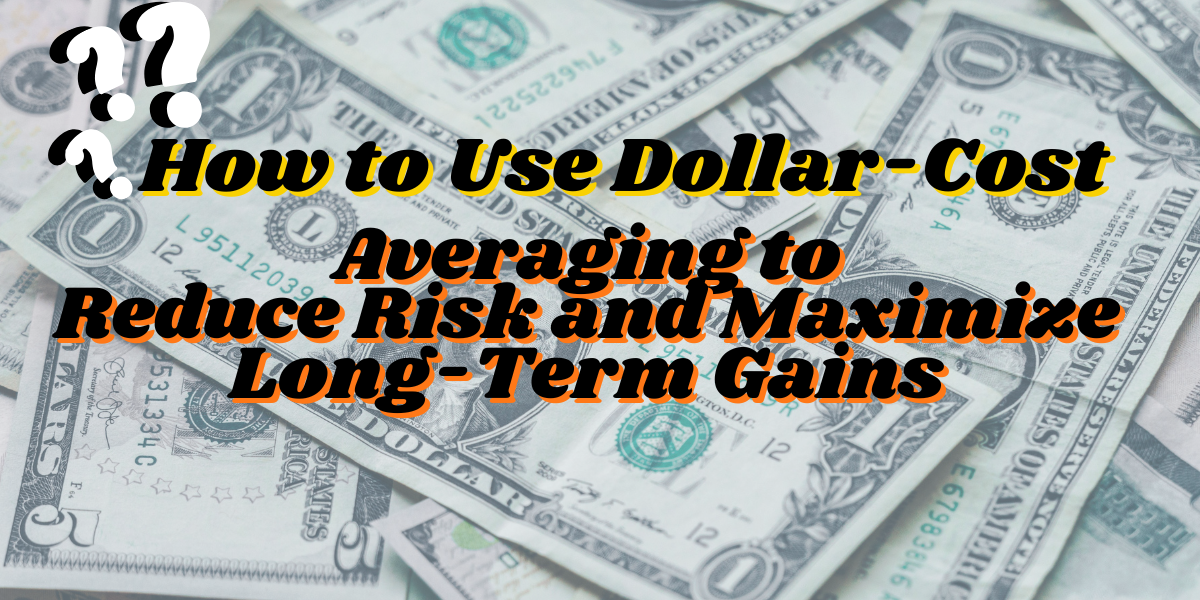Introduction
When it comes to investing, one of the biggest challenges is navigating market fluctuations. Many investors are tempted to time the market, but even seasoned professionals struggle with predicting its ups and downs. A more reliable approach is Dollar-Cost Averaging (DCA), a strategy that doesn’t require perfect timing but instead takes advantage of market volatility to gradually build wealth. Through consistent, fixed investments over time, DCA minimizes the emotional aspect of investing while maximizing long-term potential.
Let’s dive into how Dollar-Cost Averaging works, how it reduces risk, and why it can be an effective way to grow your investments.
The Fundamentals of Dollar-Cost Averaging
Dollar-Cost Averaging involves investing a set amount of money at regular intervals, regardless of the asset’s price at that time. For example, rather than investing a lump sum of $12,000 all at once, you might invest $1,000 every month for a year. This approach allows you to buy more shares when prices are low and fewer when they are high, thus averaging out your cost over time.
While this may sound simple, its impact on long-term investments can be profound, especially in volatile markets. DCA protects investors from making the all-too-common mistake of pouring large sums of money into an asset just before it dips. Instead, it fosters a patient, disciplined approach to investing.
Real-World Example
Imagine you’re investing $500 each month into a mutual fund. Over the course of six months, the fund’s price fluctuates like this:
- Month 1: $50 per share (10 shares)
- Month 2: $45 per share (11.11 shares)
- Month 3: $55 per share (9.09 shares)
- Month 4: $40 per share (12.5 shares)
- Month 5: $60 per share (8.33 shares)
- Month 6: $50 per share (10 shares)
After six months, you’ve invested $3,000. The total number of shares you’ve accumulated is 61.03, and your average cost per share is about $49.16. Despite the price volatility, your average cost is lower than the highest price paid ($60), demonstrating the power of DCA in volatile markets.
How Dollar-Cost Averaging Reduces Risk
One of the greatest fears for any investor is poor timing—investing a large sum of money right before the market takes a downturn. Dollar-Cost Averaging eliminates this risk by spreading out your investments over time. You don’t need to worry about buying at the peak because your regular contributions help smooth out the highs and lows.
For instance, during market corrections, your fixed investment buys more shares at lower prices, which sets you up for higher returns when the market recovers. In bullish periods, you purchase fewer shares, but you continue to invest, ensuring you don’t miss out on the growth.
This method reduces the emotional stress that comes with trying to time the market. It keeps you invested regardless of market conditions, fostering long-term discipline—a key ingredient to successful investing.
Volatility as Your Ally
Market volatility can be unnerving, but DCA turns it into an opportunity. When prices drop, your fixed contribution buys more shares, lowering your average cost per share. When prices rise again, the shares you acquired at a discount contribute to a larger gain. Essentially, volatility becomes your ally rather than something to fear.
By staying consistent, Dollar-Cost Averaging helps to reduce the impact of short-term market fluctuations on your overall investment strategy, making it a great tool for risk-averse investors.
Maximizing Long-Term Gains with DCA
Dollar-Cost Averaging may not guarantee quick profits, but it excels in building wealth over the long term. The key is patience and consistency. Over time, this strategy allows you to capitalize on market dips, steadily accumulate shares, and take full advantage of compound interest.
Compound interest is particularly powerful when combined with DCA. As your investments grow, the returns generated are reinvested, leading to exponential growth. The more time you give your investments, the more you can benefit from compounding.
Compounding and Dollar-Cost Averaging
Consider this example: You invest $500 monthly in an index fund with an average annual return of 7%. After 10 years, your total contributions will be $60,000, but with compounding, your investment could grow to over $83,000. After 20 years, your $120,000 in contributions might grow to nearly $264,000, thanks to the combination of regular contributions and compounding returns.
By investing consistently over time, even modest contributions can grow into substantial sums. The longer your investment horizon, the more you can benefit from the compounding effect.
Who Benefits Most from Dollar-Cost Averaging?
Dollar-Cost Averaging is well-suited to a wide range of investors. It’s especially beneficial for long-term investors who want to build wealth gradually and methodically. Those saving for retirement, such as professionals contributing to a 401(k) or entrepreneurs investing in index funds, can particularly benefit from this strategy.
It’s also ideal for new investors who might be wary of investing a large lump sum, as well as those who prefer a passive investment approach. With DCA, there’s no need for constant market monitoring or trying to outguess market movements. The strategy works in both up and down markets, providing a sense of security for those concerned about risk.
Dollar-Cost Averaging in 401(k) and IRA Plans
Many people are already using Dollar-Cost Averaging, often without realizing it. Contributions to 401(k) and IRA plans are typically made on a regular basis—whether weekly, bi-weekly, or monthly. These contributions are automatically invested in chosen funds, creating a built-in DCA strategy.
By sticking with a regular contribution schedule, employees are already reducing the risk of poor market timing and setting themselves up for long-term growth.
Why Lump-Sum Investing Isn’t Always the Answer
While lump-sum investing can lead to significant gains if the market happens to rise immediately after the investment, it also exposes you to considerable risk if the market drops soon after. Timing the market correctly is incredibly difficult, even for experienced investors. DCA, on the other hand, minimizes the risk of such bad timing by spreading out investments over time.
For example, if you invested $10,000 in a stock or fund at the beginning of 2008, just before the financial crisis, you would have seen a significant loss within months. However, if you had spread that investment over the course of the year using Dollar-Cost Averaging, your average cost would have been much lower, and you would have been better positioned to benefit from the eventual market recovery. This method highlights why online investing platforms often encourage a consistent, gradual investment approach to manage risk effectively.
The Emotional Advantage of Dollar-Cost Averaging
Another advantage of DCA is the way it helps investors stay calm during market downturns. When prices fall, many investors panic and sell their holdings, locking in losses. With DCA, you’re continually buying shares, which can help reduce the emotional urge to make rash decisions during turbulent times.
This strategy allows you to embrace market dips rather than fear them, knowing that you’re purchasing more shares at lower prices.
Dollar-Cost Averaging in Different Asset Classes
While DCA is often associated with stock market investments, it can also be applied to a variety of asset classes, including bonds, mutual funds, ETFs, and even cryptocurrencies. The principle remains the same: invest a fixed amount at regular intervals to reduce risk and smooth out volatility.
DCA in Cryptocurrencies
Cryptocurrencies, known for their extreme volatility, can also benefit from a DCA approach. Instead of trying to time the market in this notoriously unpredictable asset class, a DCA strategy allows investors to accumulate crypto assets over time, reducing the impact of sharp price swings.
For example, if you’re interested in investing in Bitcoin, a DCA strategy would involve purchasing a fixed dollar amount of Bitcoin each month, regardless of its price. Over time, this approach could help you accumulate a meaningful amount of Bitcoin while minimizing the risk of buying at a peak.
Conclusion
Dollar-Cost Averaging is a powerful, time-tested investment strategy that reduces the risk of market timing while allowing investors to capitalize on volatility. By making consistent contributions over time, you can build wealth steadily, avoid the emotional pitfalls of market fluctuations, and benefit from the compounding effect.
Whether you’re saving for retirement, diversifying your portfolio, or cautiously entering a volatile asset class like cryptocurrencies, Dollar-Cost Averaging is a straightforward yet highly effective method to achieve your financial goals. By staying consistent and patient, this approach can help you maximize long-term gains while minimizing risk—turning the unpredictability of the market into a strategic advantage.


 Tags:
Tags:










